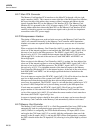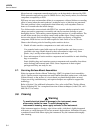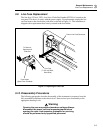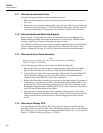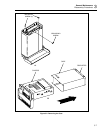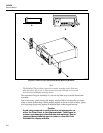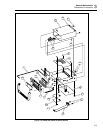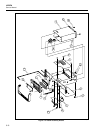
General Maintenance
Introduction
3
3-3
3-1. Introduction
This section provides handling, cleaning, fuse replacement, disassembly, and assembly
instructions.
3-2. Warranty Repairs and Shipping
If your instrument is under warranty, see the warranty information at the front of this
manual for instructions on returning the unit. The list of authorized service facilities is
included in Section 6.
3-3. General Maintenance
3-4. Required Equipment
Equipment required for calibration, troubleshooting, and repair of the instrument is listed
in Section 4 (Table 4-1.)
Refer to the Fluke "Surface Mount Device Soldering Kit" for a list of special tools
required to perform circuit assembly repair. (In the USA, call 1-800-526-4731 to order).
3-5. Power Requirements
Warning
To avoid shock hazard, connect the instrument powercord to a
power receptacle with earth ground.
If you have not already done so, plug the line cord into the connector on the rear of the
instrument. The instrument operates on any line voltage between 90V ac and 264V ac
and at any frequency between 45 and 440 Hz. However, the instrument is warranted only
to meet published specifications at 50/60 Hz. The instrument also operates from dc
power (9 to 16V dc). DC input power is connected to the rear input connector J6, pin 8
(DCH), and pin 7 (DCL). If both ac and dc power sources are connected to the
instrument, the ac power source is used if the ac line voltage exceeds approximately 8.3
times the dc voltage. Automatic switchover between ac and dc occurs without
interrupting instrument operation. The instrument draws a maximum of 10 VA on ac line
power or 4W on dc power.
3-6. Static Safe Handling
All integrated circuits, including surface mounted ICs, are susceptible to damage from
electrostatic discharge (ESD). Modern integrated circuit assemblies are more susceptible
to damage from ESD than ever before. Integrated circuits today can be built with circuit
lines less than one micron thick, allowing more than a million transistors on a 1/4-inch
square chip. These submicron structures are sensitive to static voltages under 100 volts.
This much voltage can be generated on a dry day by simply moving your arm. A person
can develop a charge of 2,000 volts by walking across a vinyl tile floor, and polyester
clothing can easily generate 5,000 to 15,000 volts during movement against the wearer.
These low voltage static problems are often undetected because a static charge must be
in the 30,000 to 40,000 volt range before a person feels a shock.




